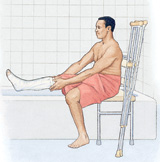These tips will help you care for your cast:
-
It will take up to 48 hours for the plaster cast to fully harden. Don't put weight on the cast during that time, or it may break.
-
To prevent swelling under the cast, do this for the first 48 hours:
-
If the cast is on your arm, keep it in a sling or raised to shoulder level when you sit or stand. Rest it on your chest or on a pillow at your side when you lie down.
-
If the cast is on your leg, keep it propped up above the level of your hip when you sit or lie down. Sleep with the cast raised on a few pillows. Stay away from crutch walking as much as you can during this time.
-
-
Keep the cast completely dry at all times. Bathe with your cast well out of the water. Protect it with two large, plastic bags. Separately close the top end of each bag with a rubber band or tape. A wet cast will soften and won't protect your injury. A wet cast may also cause skin problems.
-
If itching develops, you can:
-
Set a hair dryer to cool and blow air under the cast.
-
Ask your health care provider about taking anti-itch medicines like an antihistamine.
-
Put an ice pack on the affected area. To make an ice pack, put ice cubes in a plastic bag that seals at the top. Wrap the ice pack in a towel before using.
-
Follow-up care
Follow up with your health care provider as advised.
When to get medical advice
Contact your health care provider right away if:
-
The cast gets wet or soft, or it cracks.
-
Bad odor comes from the cast, or fluid from the wound stains the cast.
-
Tightness or pressure under the cast increases.
-
Your fingers or toes become swollen, cold, blue, numb, or tingly.
-
Pain under the cast gets worse.
-
The cast becomes too loose.
-
You can't move your fingers or toes.
-
You have a fever.
-
You have chills.


